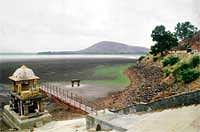
The tank, spread across 4,416 acres is a treat to the eye, nestled as it is in a hilly region. All the rain that the surrounding villages receive flows into the mighty Sulekere.
The tank is not without its share of history and legend. Popular local legend here says that the tank region was earlier a town called Swargavathi, ruled by a prince called Vikramaraya. Localites credit the building of the tank to Shantaladevi, the lone daughter of Vikramaraya and his wife Nutana devi.
History also has it that the British engineer of erstwhile Mysore state, Sankey once commented that the region (where Sulekere once was) was not ideal for the construction of a tank, but was still built all thanks to the engineering expertise of people of those times. It is indeed remarkable, he commented.
The tank has two canals, one to the north, called the Siddha canal, and the other to the south, called Basava canal. The tank provides irrigation facilities to 15 to 20 villages (spread across 2,000 acres), and caters to the drinking water needs of Chitradurga.
There is a Siddeshwara temple belonging to the Hoysala and Keladi style of architecture towards the east of the tank. There is an attractive stone mantapa on the banks of the tank.
Full of silt
Today, though, the tank with water level of 27 feet has ten feet of silt. The tank’s bund was broken way back in 1992.
That happened again, 17 years later, in 2009. This caused a lot of damage to the region. The backwaters submerged nearly 3,500 acres of land in the surrounding villages. This can be avoided if proper de-silting works are undertaken from time to time.
In times gone by, tanks were de-silted often, and the villagers who would take care of the tank, were rewarded appropriately. They would be doled out tax exemptions. There is mention of the same in Kautilya’s Arthashastra.
Today, though, there is no system in place to de-silt the tank. The second largest tank in Asia also goes by the name of Shantisagar, in memory of Shantaladevi. It is important that this tank, that provides water to hundreds of villagers is taken care of properly.
B P Kumar Davangere